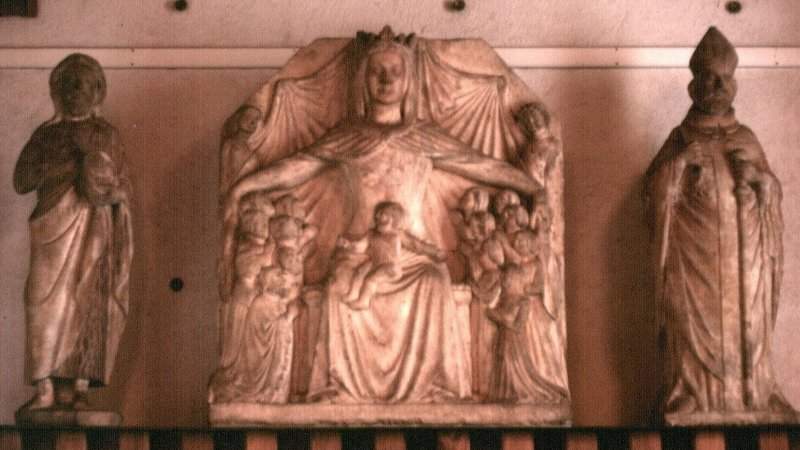Repatriation... Of province: Monza asks Milan to return a sculptural group from the 1300s
Monza calls Milan and asks the regional capital to return a work of art from the city of Brianza now kept at the Castello Sforzesco: the singular request was made with a petition on Change.org promoted by a Monza citizen with a passion for history, Ettore Radice, and supported by several cultural associations in the area (including Mnemosyne, La Casa della Poesia, Italia Nostra, Amici dei Musei, Pro Monza and Università Popolare Upm). It is a 14th-century tabernacle depicting Our Lady of Mercy flanked by Saints John the Baptist (co-patron saint of Monza) and Ambrose (patron saint of Milan, to whom Monza was subject at the time the sculptural group was made).
“Our city, in the most difficult moments of its History,” the text of the petition explains, “trusted in the Virgin’s help, addressing supplications to her to support the people of Monza in overcoming adversity. The most important representation of this devotion is in the 14th-century Madonna (called Madonna of Mercy by some sources) with the spreading mantle that was placed above the vault of Porta Milano or Porta Nuova (present-day Largo Mazzini), below the Visconti castle, the main entrance to the city, from where the road to Milan began.” The tabernacle, the petition continues, “owned by the state and in storage in Milan, would deserve a location more favorable to its enhancement in its city of origin, as it represents a religious symbol but also a civil one, before being historical and artistic.” The citizens also propose the location of the work: the Monza Civic Museums’ home of Casa degli Umiliati. The petition is addressed to the minister of cultural heritage, Dario Franceschini, and the mayor of Monza, Dario Allevi.
A few days ago, moreover, the citizens were joined by a Brianza deputy of the League, Massimiliano Capitanio, who addressed a parliamentary question to the minister of cultural heritage Dario Franceschini, together with his colleague from Treviso, Angela Colmellere, to ask the holder of the Collegio Romano whether it is possible to take action, in conjunction with the territorial bodies concerned, to ensure that Milan returns the Madonna of Mercy to Monza.
“With the advent to the Signoria of Azzone Visconti, lord of Milan from 1329 to 1339,” Capitanio explains, “it was decided to rebuild the city walls of Monza that had first been erected in the early Middle Ages; the Visconti defensive wall, begun in 1333 and finished in 1385, stretched for more than two kilometers and was equipped with numerous defense towers and gates built of stone and brick like small forts, with Ghibelline battlements, portcullises and drawbridges. The main gate, the one known as the ’New’ gate, in the direction of Milan, was adorned on the top with an imposing high relief depicting Our Lady of Mercy, an effigy of Mary spreading her mantle to protect the city, in which the Virgin is in the center and holds men to her right and women to her left.”
The work, Capitanio continued, “has always had a deep religious value for the citizens, as it is to that Madonna that the city turned to ask for her intercession during wars and famines until 1839, when the city walls were demolished and the work of art transferred to Milan, the province to which Monza had been annexed.” Our Lady of Mercy, as mentioned, was in ancient times flanked by the statues of St. John the Baptist and St. Ambrose, and constituted a votive tabernacle much venerated by the population. The entire group is now at the Castello Sforzesco, kept in the Museum of Decorative Arts: in particular, it is located in an antechamber of the Sala della Balla that houses the group of twelve tapestries of the Months, made to a design by Bramantino around 1509.
“It seems evident,” Capitanio argues, “that the high relief in question, a symbol of medieval Monza and an object of enormous devotion for the Monza citizenry, instead holds very little importance within the collections of the Milanese museum pole, which, in the questioner’s opinion, has never enhanced its presence with an adequate exhibition; the city of Monza has asked to regain possession of Our Lady of Mercy and the statues that flank her and, especially in these months of health emergency in which the Pope has entrusted Italy and the world to the protection of the Mother of God as a sign of salvation and hope, it is returning to ask to bring home the precious tabernacle.”
“To date,” the Leghist deputy reports, “the requests made by the Civic Museum of Monza and by the municipality itself to the Civic Museums of Milan, to the knowledge of the questioners, have remained without any response; the location of the entire sculptural group in a special room of the Civic Museum of Monza, at the House of the Humiliated, would enrich not only the artistic heritage but also the intangible cultural heritage of the city, thus ensuring greater protection for the high relief.” Hence the request to have the work returned to the city. The request, moreover, is not new: Radice himself had already tried, in 2004, to return the sculptural group to the city. His request, submitted to the city council, was voted unanimously, but was not followed up. Will it now be the right time for the Madonna of Mercy to return to Monza?
Pictured is the work whose return is being requested.
 |
| Repatriation... Of province: Monza asks Milan to return a sculptural group from the 1300s |
Warning: the translation into English of the original Italian article was created using automatic tools. We undertake to review all articles, but we do not guarantee the total absence of inaccuracies in the translation due to the program. You can find the original by clicking on the ITA button. If you find any mistake,please contact us.





























